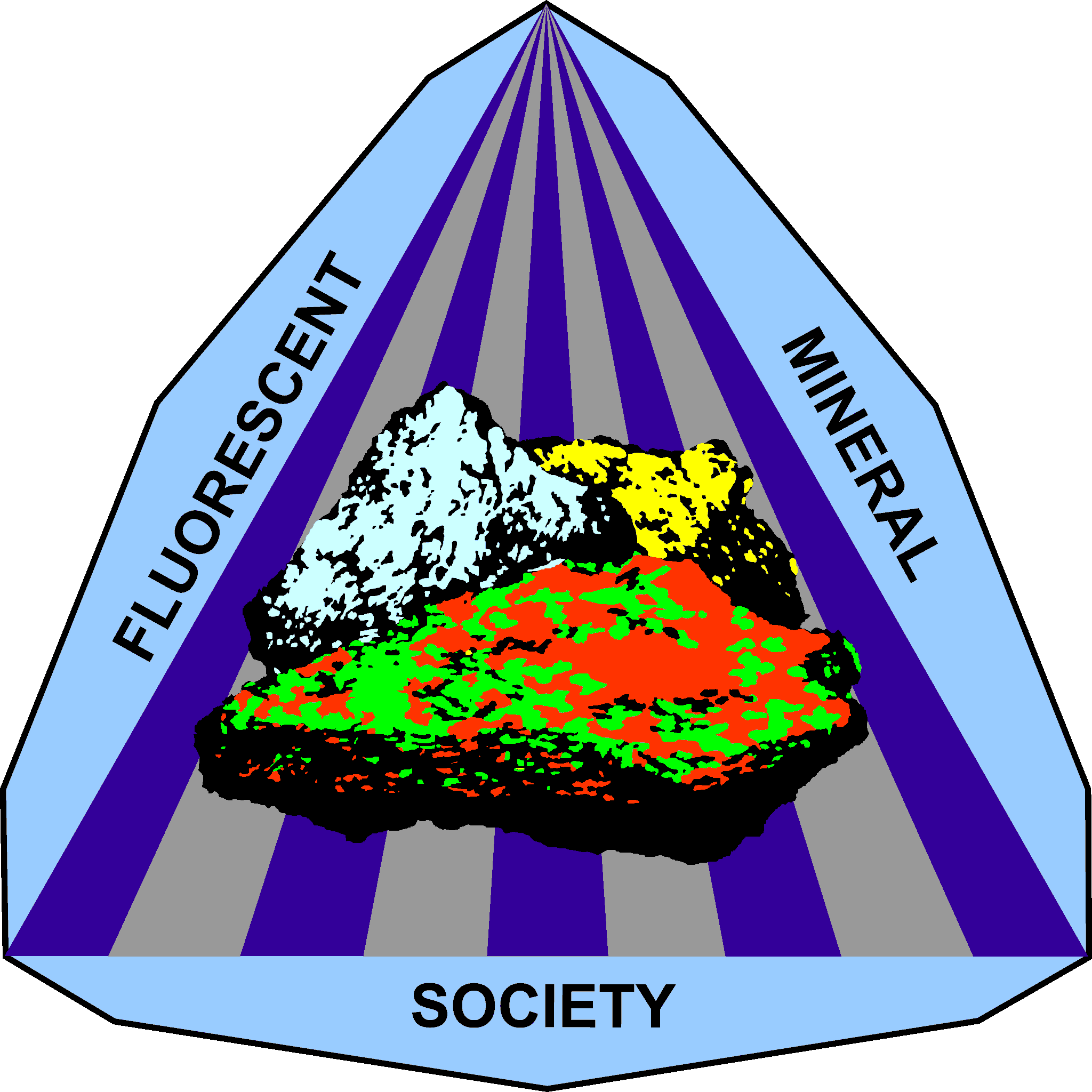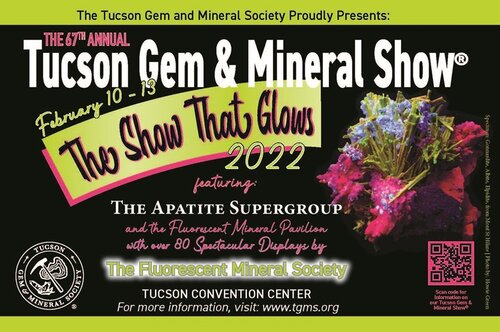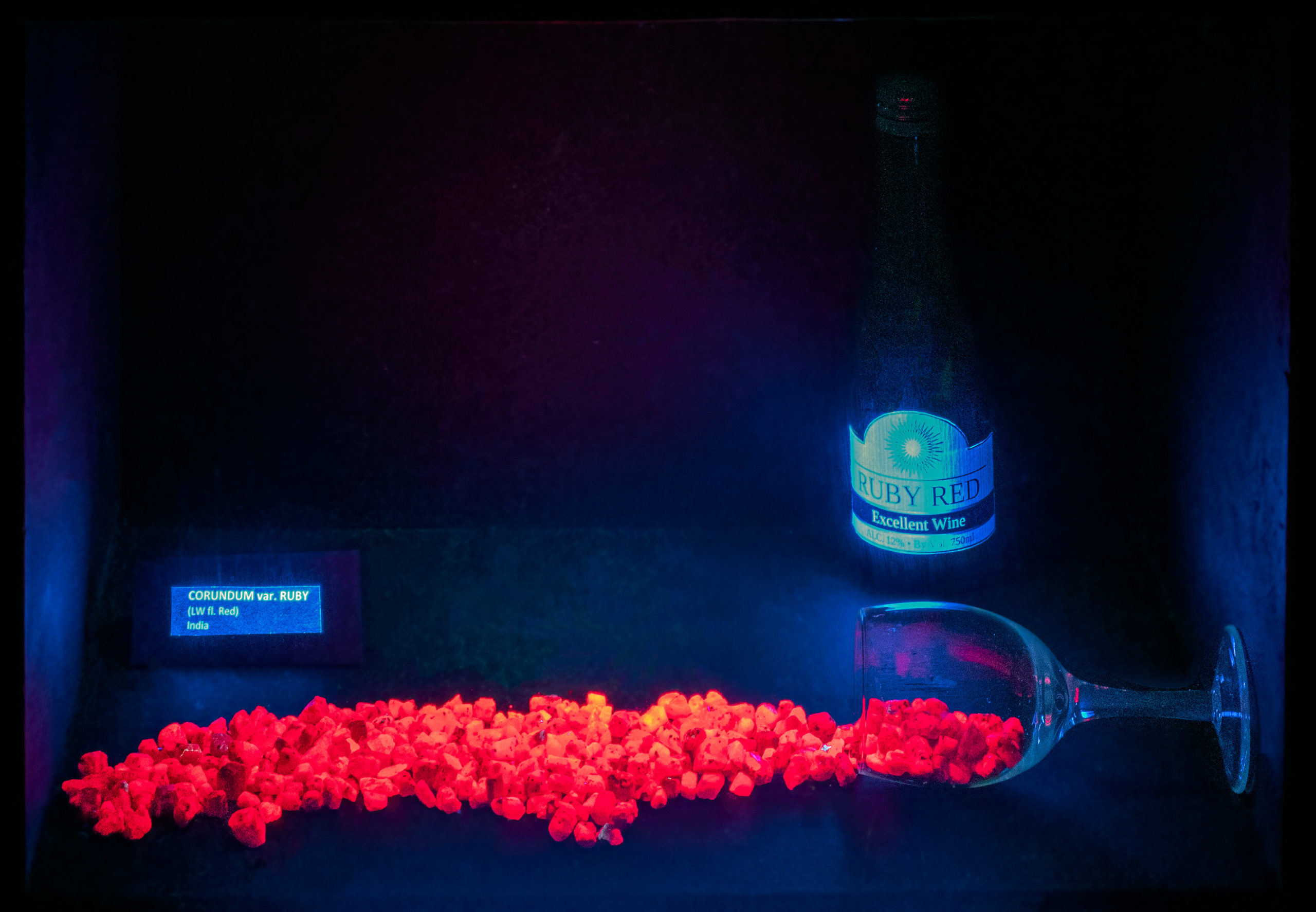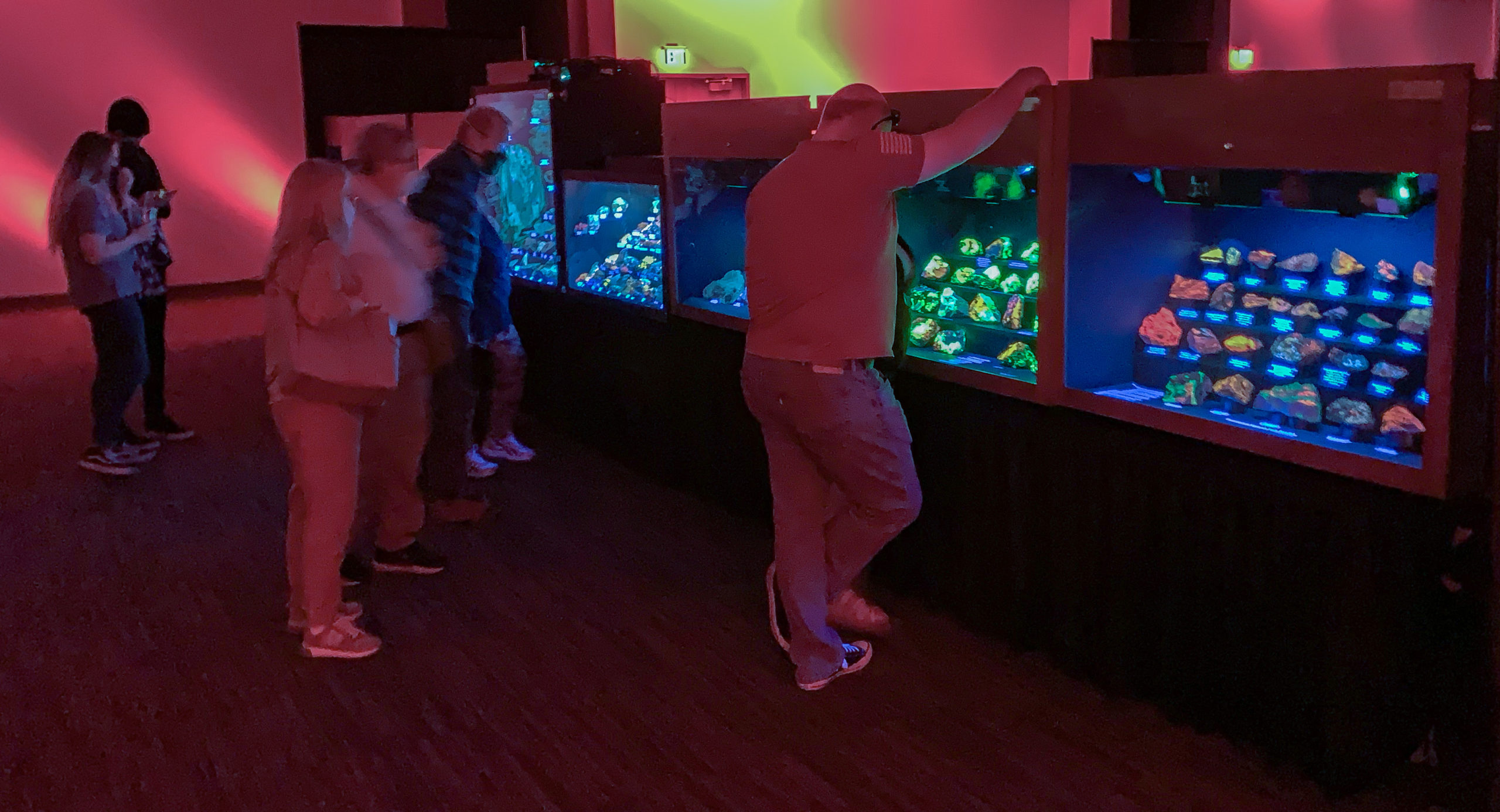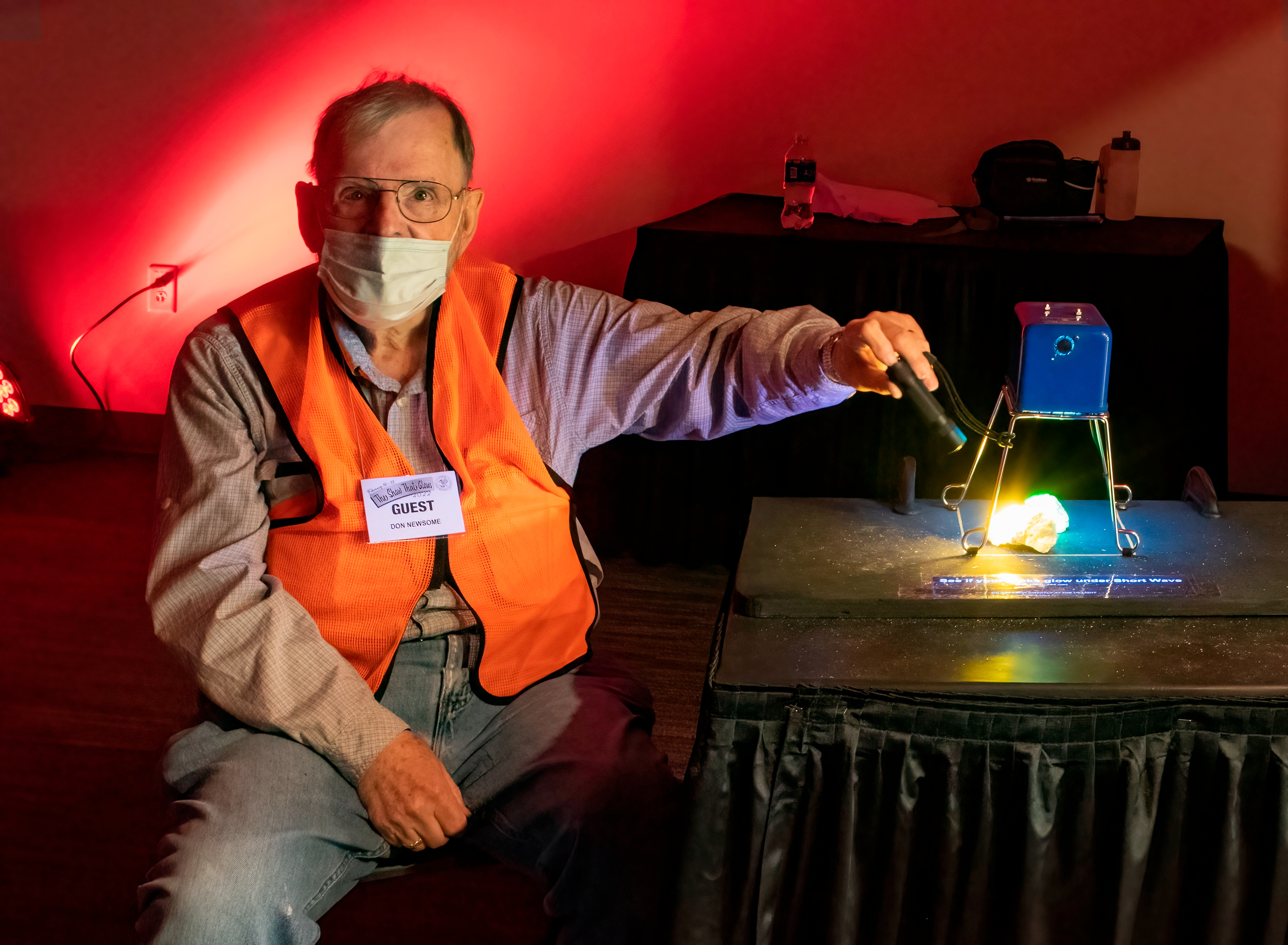The TGMS and Annual Show
The Tucson Gem and Mineral Society (TGMS) formed in 1946, and the first Tucson Gem and Mineral Show® was held in a local elementary school in 1955. The show grew to the point that in 1972 it moved to its present location in the Tucson Convention Center. The 2022 show was the 67th show. Over the years it has grown to become the largest, oldest, and most prestigious show in the world. The first satellite show was in 1961. By 2017 there were over 48 satellite shows with thousands of dealers and tens of thousands of attendees from everywhere in the world.
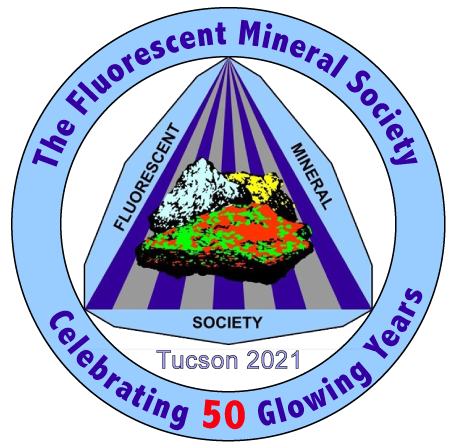
The FMS 25th Anniversary Show (1996)
The Fluorescent Mineral Society (FMS) was founded in 1971, incorporated in 1993, and became a non-profit organization in 2018. The TGMS show had displays by the Sterling Hill Mining Museum, New Jersey, in 1992 and 1994, but neither included a fluorescent display. It wasn’t until 1996, the 25th anniversary of the FMS, that the first major fluorescent displays were presented at the TGMS show. Special arrangements were made with the FMS, and it was billed as “The Show That Glows”. This was the largest such exhibit at any show, with dozens of cases illuminated by short wave and long wave ultraviolet lights. The exhibit was in a side room to the main show, referred to as “The Bat Cave.” There were no windows, and it was kept dark (I recall some black plastic sheeting?) except for the lights in the cases. Don Newsome, founder of the FMS, led the cooperative planning effort to ensure that these exhibits were outstanding.
Collectors from all over the country brought specimens and lights to fill the cases with brilliant colors; this was truly outstanding as the first time this extensive of an exhibit of fluorescent minerals could be seen outside of the displays at Franklin or Sterling Hill, New Jersey. The cases were incredibly beautiful, one row after another filled with fluorescent minerals from all over the world. While not one case or specimen stands out in my mind (it was sensory overload), I do recall at least one or two cases with revolving spheres of Franklin or Sterling Hill specimens, and possibly an HO scale train loaded with various specimens chugging through its case. Many cases featured minerals I had never actually seen or even knew of. There were also cases representing individual localities, states, and countries. I recall taking a few photos, but where these ended up over the years I can’t say. (I also gave a presentation at the show, entitled Fluorescent Minerals of the Karnes Uranium Mining District, South Texas). There was so much to take in that my mind was a whirl. You had to be there to appreciate it, as nothing of this scale had previously been done. One last note of interest: since the 1996 show, there has usually been one case of fluorescent minerals shrouded in black plastic on the main show floor showing attendees a small taste of the wonders of fluorescent minerals.
Flash forward twenty-five years to 2020, when preparations were being made for an updated version of the 1996 TGMS show honoring the 50th anniversary of the FMS. Considerable advances had been made in the mass production of ultraviolet lights, including new manufacturers of more powerful lights, experience with modified for display mid-wave (MW) UV-emitting transilluminators, inexpensive and high- quality LED Long Wave (LW) lights, and numerous flashlights, made possible by the development of a high-quality Short Wave (SW) and MW LEDs. These advances resulted in an increase in the number of fluorescent mineral collectors along with regional and local chapters of such collectors, and in new minerals and locations being identified. Many local shows around the world featured fluorescent mineral exhibits, as did school science nights and classes. UV lights had gone from black lights for postage stamps, currency, identifying where the pet relieved itself on the rug, and the psychedelic posters and other items of the 60s and 70s to reach a whole new level.
Preparation for the FMS 50th Anniversary Show
Planning began in 2020, but concerns about safety due to the COVID-19 pandemic forced the cancellation of the 2021 TGMS show. This allowed much needed extra time for the FMS to better prepare for “The Show That Glows 2”. Al Liebetrau, as Chairman of the FMS TUC ’21 Committee, took the brunt of the organizational efforts and was the liaison between the FMS and the TGMS. Cec De Clerck was Al’s administrative assistant, and like most who hold this responsibility, kept things moving forward and all involved informed and on the same page. Individual Group Leaders were appointed to organize the participants in their area by relaying information and deadlines to and from them and inform the chair. The possibility of cancellation due to COVID-19 required special coordination between all involved. A final item worthy of mention were the seemingly endless number of Zoom virtual meetings of these organizers, also an essential task in helping to make the show a success. Commitment to these meetings amounted to many hours.
Those who provided displays and presentations at the show are also to be congratulated. Lastly, there were numerous tasks that were essential in making this show happen, including the TGMS, museums and dedicated individuals who drove trucks from distant regions to take cases, lights, and specimens to the show, the numerous borrowed cases, the making of risers, liners, setting up the cases, attaching UV lights inside the cases. Countless volunteers were needed to prep for the show or participate as adjuncts to for each task.
The FMS 50th anniversary “Show That Glows 2” finally took place in February 2022. Cases and display contents were received and secured in Tucson beginning on 2/5/22, and the main setup date was 2/9/22, when displayers picked up their registration packets and badges prior to being allowed access to the display area and main show floor. A rough set up time schedule helped people to smoothly move in their specimens and other items, and get their lights and cases set up on the Wednesday afternoon before the show opened. Novices in show set up were assisted by more experienced displayers. Specimen layout, labels, liner color, number of risers, lights, their location, and angle of the lights in the case are all important.
The 2022 “Show That Glows”
The actual 67th TGMS show was held on 2/10-13/22. There were three FMS display cases on the main show floor. Don Newsome had a case devoted to the history of the FMS. I had a case of various old and new UV lights I collected to show some of the developments over the years. Numerous show attendees, both FMS members and non-members, could be seen looking over these cases and commenting on which of the lights in the case they had once used in years past. The FMS also had a lone case shrouded in black plastic with about 12 specimens from various members who entered individual specimens in the competition for best LW specimen and, best SW specimen. The cases in the Bat Cave were automatically included in the competition for the best overall case.
The main fluorescent display room included 54 cases of various sizes. This was less than some 80 cases initially anticipated in 2021, before COVID-19. Still, the cases included a good selection of fluorescent minerals and even some fossils replaced by minerals from worldwide localities. The cases in the rear of the room had a timed/repeating voice recording synchronized to show and tell viewers about the different wavelengths of lights, how some minerals react under each, and other items of interest showing these cases under regular, SW, LW and MW fluorescence. The first case the viewers saw in the “tour” of these changing cases included a revolving sphere of Franklin or Sterling Hill material of the typical red and green fluorescence. There was also a lone, small case with gems that fluoresced.In general, tremendous diversity was characteristic of the displays. Some cases included some large specimens, others small specimens; many had a mixture. Some had all one mineral the same color, or that were self- collected, from one state, area, state, or country. One case was larger than the others and had varieties of fluorescent petrified wood, ammonites, and other fossils replaced by minerals. There were two displays set apart at the front of the three or four rows of displays; one had a single, large specimen from New Jersey, demonstrating the colors with different lights. The other was an HO train setup with cars of different color-fluorescing minerals being drawn around through a tunnel.
The Satellite Shows
There were many satellite shows to attract visitors, and these added to the cacophony of minerals, fossils, and gems that overwhelm Tucson at this time every year. At least one FMS member was a vendor at the Miner’s Coop Show in the northern part of the city, even having a large, enclosed darkened area to enable buyers to see these specimens under UV lights prior to buying. The 22nd Street Show was as big as always, but I didn’t see too much in the way of fluorescent minerals as I have seen in years past. The Kino Gem and Mineral Show was also extensive and had some knowledgeable fluorescent dealers offering good prices. I was able to score a nice flat of yellow fluorescing cerussite with barite from Morocco. As possibly the largest satellite show, it is nearly overwhelming to take it all in. Kino also had some very large specimens that always impress me. On Saturday afternoon, I went to several venues on Granada Avenue. Unfortunately, many dealers were already in the process of packing up and moving out by that time. Another place I would suggest going to earlier in the week is the new University of Arizona Alfie Norville Gem & Mineral Museum, a short distance north of the TCC. Unfortunately, it is not open on Sundays or Mondays at present, so this is one place I will make sure I see the next time I attend the TGMS show. The Museum includes the minerals formerly kept in the basement of the Flandrau Museum on the UA campus, and officially opened on July 19, 2021. The grand opening was scheduled to be on February 3, 2022, the week prior to the TGMS show.
An Impromptu Field Collecting Trip
The reason I was unable to do much related to the shows in Tucson on Saturday, February 12th, was because Paul Gilliam led Bruce Cox and myself to some scheelite prospects outside of Oracle, Arizona, a little over an hour north of Tucson. One adit was particularly good for collecting fluorescent specimens of red calcite and bluish-white scheelite. We had our bags full after about an hour, and walking them back down the somewhat steep and rugged road was a bit difficult. A great time was had by all. Bruce and I also checked out another scheelite prospect off Hwy. 80, just south of Roadforks, NM. Trying to collect fluorescent minerals in an unfamiliar place in the daytime without the proper equipment wasn’t the smartest thing to do, but there were some interesting rocks at one prospect. Unfortunately, the majority of the prospects with larger spoils were on the other side of a locked gate with a “No Trespassing” sign, preventing us from collecting. Still, a bad day collecting is better than a good day in most other situations. Maybe next time.
In closing, even with the show being cancelled in 2021 and all the difficulties, hard work, and hours of time that went into this, the result was well worth it. Hopefully, “The Show That Glows” will spark interest in others to join the ranks of our Society’s specialty niche in the world of mineral enthusiasts. And as I usually tell people at our show’s fluorescent display, “I never get tired of these minerals.” We’ll see you, Lord willing, in another 25 years. Till then, via con Dios, amigos y amigas.
